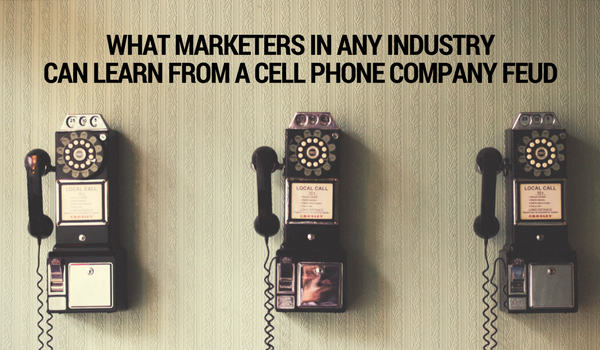
Last night, I watched the Super Bowl along with millions of other sports fans and ad watchers. I tweeted about the ads, took copious notes to be able to write our annual review of the ads, and watched as Tom Brady made a spectacular comeback against Matt Ryan’s Falcons (you’ll get ’em next time, Matt!).
As I sat back after the game ended, I realized I had one brand name stuck in my head over and above all of the others whose commercials I had seen: Verizon—and they didn’t even have a commercial during this year’s game! Why would I have their name stuck in my head like a catchy pop song?
It has to do with all of the negative ads towards Verizon. Sprint and T-Mobile tried desperately to persuade the audience to leave Verizon and come to their network. The problem with these commercials is that they mention or visually refer to their competitor more than they refer to themselves. Let’s take a look.
Sprint
In Sprint’s ad, Paul-the-Sprint-Guy uses the word “Verizon” three times, compared to Sprint just once. And yes, there’s the Sprint logo at the end of the commercial, but most of the ad time is spent trying to persuade the audience that a 1% difference isn’t that big of a deal (a stat which Verizon was ready to counteract).
T-Mobile
T-Mobile uses Verizon’s name three times over the two commercials, and their own name just twice. Plus, T-Mobile uses Verizon colors (red, black, and white) in their two Super Bowl ads, even going so far as to have an entire character be a Verizon customer service representative.
Lesson to Be Learned
Time will tell whether Verizon or their competitors receive more sales from these commercials, but I wouldn’t be surprised if Verizon came out ahead, without having to even spend money on a game night ad. I couldn’t have been the only one hearing “Verizon” come from my TV screen, and do I care that it came from their competitors? Not really. All I remember is Verizon, and if I were in need of a new phone or contract, that’s where I would be heading today.
A while ago I was listening to this podcast called Under the Influence by Terry O’Reilly and it was going through how brands have repositioned their competitors (namely the top brand in the industry) by calling out negative aspects of being number one. O’Reilly brought up classic marketing case studies, like Avis’ proud claim of the #2 title, just behind Hertz, as well as Tylenol’s branding winning out over aspirin’s reign of pain relievers. These brands repositioned not only themselves but also their competitors by displaying how the strength of being number one could also be a weakness.
I bring this podcast episode up only to point out that neither Sprint nor T-Mobile are repositioning themselves or using Verizon’s weaknesses to boost themselves up. Sure, they mention Verizon’s fees and overages or how close their reliability stats are to being the same. But it’s straight forward facts and comparison. It’s not telling the audience how different or special their network and services are—it’s using Verizon as the gold standard in cell phone coverage and comparing themselves to that.
What This Means For You
When trying to reposition your company in the industry, assess weaknesses in your competition: products, services, customer service, etc. Then identify how your company compares and where they excel in those weaknesses above the leader. Use those strengths as starting points for advertisements and other collateral that can outshine the competition.
Don’t compare yourself to your competitors. You don’t need to say their name in your ad or marketing materials. Focus on what you bring to the table, how what you’re doing is different than anyone else—your company’s assets are the only ones that need to shine.
Who do you want your audience to remember: you . . . or your competitor?
{{cta(‘e7e5df4e-5b4a-4d7e-bd02-bdb1568c11d5’)}}
